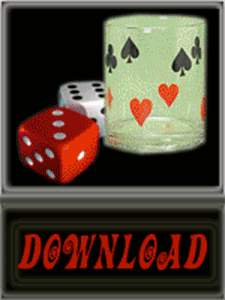Pokerwiner.com → Lessons of poker
DRAWING TO THE SECOND-BEST HAND
Equally important in determining whether a hand that needs improvement is worth a call is the question of whether the hand will win even if you do make it.
Your hand might lose in a variety of ways. It can happen because you are drawing dead that is, the hand you are looking to make is already beaten by your opponent.
For example, when that open pair bet into your four-flushes and a possible straight earlier in this chapter, he might have been betting a full house, which you have no way of beating.
It can also happen that you make your hand and your opponent makes an even better hand even though you weren’t drawing dead.
Your four-flush might, for example, be up against three-of-a-kind. You may make your flush, but your opponent may very well make a full house.
In such situations you must reduce your odds of winning and sometimes throw your hand away.
For instance, a four-flush against three-of-a-kind in seven card stud is a much greater underdog than a four-flush against two pair because three-of-a-kind is more than twice as likely to improve to a full house.
The ability to fold correctly when you suspect you are drawing dead or drawing with too little chance of ending up with the best hand in one attribute that distinguishes a good player from an average one.
One the other hand, poor players are likely to call thoughtlessly on the come no matter what.
They do not consider that they may be drawing dead; and when they’re not drawing dead, they do not adjust their chances of ending up with the best hand, taking into account the possibility of an opponent’s making a bigger hand than their own.
In holdem and other community card games, you can sometimes draw dead because the free cards that will give you the hand you want will also give your opponent an even better hand. Suppose in holdem you are holding


your opponent is holding


and the board is




If a queen falls on the end, you make a straight, to be sure, and a straight beats three jacks. However, the queen also happens to give your opponent a full house. Similarly, if you hold


and the board is




there is no card in the deck that will make you a winner against an opponent holding the ace of hearts and another heart. A heart at the end gives you a king-high flush, but it gives your opponent an ace-high flush.
When you think you opponent might beat you even if you make your hand, you must adjust your odds of winning before comparing them to the pot odds you are getting.
Let’s say you ate a 5-to-1 underdog to make your hand, and you are getting 7-to-1 from the pot. By itself your hand is worth a call.
But suppose you feel there is a 30 percent chance your opponent will make a hand that beats the one you are trying to make.
Should you will call? As a 5-to-1 underdog you are going to make your hand one-sixth of the time, which is 16²∕³ percent.
However, of that 16²∕³ percent of the time, you will be good only 70 percent of the time. All of a sudden, instead of winning 16²∕³ percent of the time, you will win only about 11²∕³ percent of the time.
You go from a 5-to-1 shot to just about a 7½-to-1 shot. What appeared to be an easy call has become a fold.
In general, you don’t need to calculate your chances of winning so precisely when there is a chance of drawing dead or being out drawn after you make your poker hand, you had better throw away most of your close plays because they will swing into losing plays.
You have to overcome the double adversity of having the worst hand in the first place and the possibility of not winning when you make the hand you are hoping to make. To call a bet in such a situation requires very good pot odds indeed.
Summary
In this chapter we have explained how to use pot odds to determine whether to call or fold with a likely second-best hand.
When all the cards are out, your hand is worth a call if you think your chances of winning are better than your pot odds.
Before the draw in draw poker and with exactly one card to come in stud games, your decision to call with a hand that needs to improve depends upon these factors:
1. Your chances of improving, taking into account the needed cards already out against you (in stud) ad any extra outs you might have.
2. Your chances of winning if you do improve.
3. The odds you are getting on this next-to-last round of betting, taking into account the possibility of a raise behind you if you are not the last to act.
4. Your expected extra profits on the last round of betting if you do make your hand.
This last factor is what I call implied odds. It is the money you expect to win by betting or raising on the last round (or rounds) when you do make your hand. I will discuss implied odd in full in Chapter Seven.
First we must consider how pot odds are affected when you are deciding whether to call in stud poker games when there is more than one card to come to come and you must anticipate having to call more than one round of betting.
This question is the subject of the next chapter.



